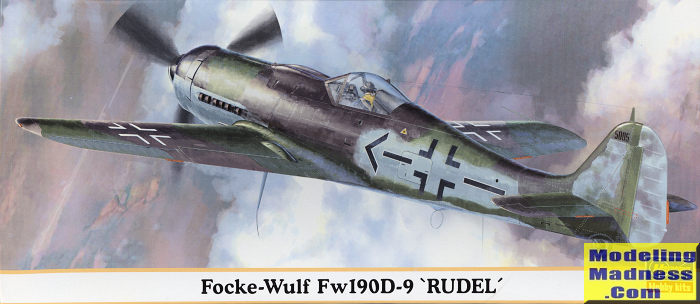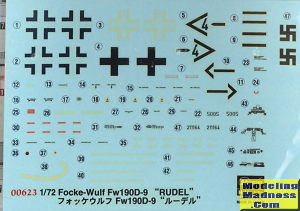
Hasegawa 1/72 FW-190D-9 'Rudel'
| KIT #: | 00623 |
| PRICE: | 1400 yen SRP, though these kits often retailed in the US for $25-30.00 |
| DECALS: | Three options |
| REVIEWER: | Scott Van Aken |
| NOTES: | 2003 Limited Edition |

| HISTORY |
The Fw 190 D (nicknamed the Dora; or Long-Nose Dora, "Langnasen-Dora") was intended to improve on the high-altitude performance of the A-series enough to make it useful against the American heavy bombers of the era. In reality, the D series was rarely used against the heavy bomber raids, as the circumstances of the war in late 1944 meant that fighter-versus-fighter combat and ground attack missions took priority. A total of 1,805 D-9s were produced. Production started in August 1944.
The liquid-cooled 1,750 PS (1,726 hp, 1,287 kW) Jumo 213A could produce 2,100 PS (2,071 hp, 1,545 kW) of emergency power with MW 50 injection, improving performance to 426 mph (686 km/h) at 21,650 ft (6,600 m). Early D-9s reached service without the MW 50 installation, but in the meantime Junkers produced a kit to increase manifold pressure (Ladedrucksteigerungs-Rüstsatz) that increased engine output by 150 PS to 1,900 PS, and was effective up to 5,000 m (16,400 ft) altitude. It was fitted immediately to D-9s delivered to the units from September, or retrofitted in the field by TAM. By the end of December, all operational Doras, 183 in total, were converted. From November 1944, a simplified methanol water (MW 50) system (Oldenburg) was fitted, which boosted output to 2,100 PS. By the end of 1944, 60 were delivered with the simplified MW 50 system or were at the point of entering service. The 115 L tank of the Oldenburg system would hold the MW 50 booster liquid, which was single purpose, while later systems were to be dual purpose, holding either MW 50 or additional fuel.
The fighter lacked the high turn rate and higher rate of roll of its close coupled radial-engined predecessor. It was a bit faster, however, with a maximum speed of 680 km/h (422 mph) at 6,600 meters (21,650 ft). Its 2,240 horsepower with methanol-water injection (MW 50) gave it an excellent acceleration in combat situations. It also climbed and dived more rapidly than the Fw 190A, and so proved well suited to the dive-and-zoom ambush tactics favored by the Schlageter pilots. Many of the early models were not equipped with tanks for methanol, which was in very short supply in any event. At low altitude, the top speed and acceleration of these examples were inferior to those of Allied fighters. Hans Hartigs recalled that only one of the first batch of Dora 9s received by the First Gruppe had methanol water injection, and the rest had a top speed of only 590 km/h (360 mph).
Due to the failure of multiple attempts to create an effective next generation 190, as well as the comments of some Luftwaffe pilots, expectations of the Dora project were low. These impressions were not helped by the fact that Tank made it very clear that he intended the D-9 to be a stopgap until the Ta 152 arrived. These negative opinions existed for some time until positive pilot feedback began arriving at Focke-Wulf and the Luftwaffe command structure.
Sporting good handling and performance characteristics, the D-9 made an effective medium altitude, high speed interceptor, although its performance still fell away at altitudes above about 20,000 ft (6,100 m). When flown by capable pilots, the Fw 190D proved the equal of Allied types.
| THE KIT |
Even though these
limited run kits seem to sell out rather quickly, if one is frugal and willing
to wait for people to get tired of them and put them on sale, they can be found
at a fairly reasonable price. However since these kits were initially released,
there have been other kit options available that the modeler my want to look
into.
 For
several years, Hasegawa re-issued this kit as part of its Limited Edition series
of aircraft. This particular boxing is a 2003 release. Unlike their initial
190D-9 kit from the early 1970s, it has the required
engraved panel lines, and a somewhat basic
interior that uses decals for instrument panels and side consoles. A drop tank
and rack are also provided. Though two styles of canopy are provided, only the
'blown' canopy is needed as all markings options are very late war planes. I'll leave it
to the rivet counters to tell you if the kit has any accuracy problems, but it
looks just fine to me. This is by no means a complex kit and those who wish to
spruce up the cockpit will find a number of aftermarket sets for it.
For
several years, Hasegawa re-issued this kit as part of its Limited Edition series
of aircraft. This particular boxing is a 2003 release. Unlike their initial
190D-9 kit from the early 1970s, it has the required
engraved panel lines, and a somewhat basic
interior that uses decals for instrument panels and side consoles. A drop tank
and rack are also provided. Though two styles of canopy are provided, only the
'blown' canopy is needed as all markings options are very late war planes. I'll leave it
to the rivet counters to tell you if the kit has any accuracy problems, but it
looks just fine to me. This is by no means a complex kit and those who wish to
spruce up the cockpit will find a number of aftermarket sets for it.
 The instructions are well done and typically use Gunze paints for the color
references. This kit uses the basic instructions with an addendum sheet for
two aircraft. One is the box art airplane as flown by super-Nazi Rudel when with
SG2 near the end of the war. The other is an aircraft from JG 51, also near the
end of the war. The decals themselves are nicely
printed and should work fairly well, but check one you aren't using as this
sheet is nearly 20 years old.
The instructions are well done and typically use Gunze paints for the color
references. This kit uses the basic instructions with an addendum sheet for
two aircraft. One is the box art airplane as flown by super-Nazi Rudel when with
SG2 near the end of the war. The other is an aircraft from JG 51, also near the
end of the war. The decals themselves are nicely
printed and should work fairly well, but check one you aren't using as this
sheet is nearly 20 years old.
| CONCLUSIONS |
Though the release of the IBG kit will undoubtedly push this one back a bit in terms of desirability, it is a fairly hassle-free build without any of the 'fiddlyness' that one often finds in newer kits. Still worth picking up.
| REFERENCES |
http://en.wikipedia.org/wiki/Focke-Wulf_Fw_190
March 2023
Copyright ModelingMadness.com. All rights reserved. No reproduction in
part or in whole without express permission from the editor. If you would like your product reviewed fairly and quickly, please
contact
the editor or see other details in the
Note to
Contributors.